Relationship between Cytotoxicity and Surface Oxidation of Artificial Black Carbon
Abstract
1. Introduction
2. Materials and Methods
2.1. Particle Generation and Thermal Treatment
2.2. Physicochemical Characterization
2.3. Endocytosis, Cytotoxicity Assay, and Evaluation of Reactive Oxygen Species (ROS)
2.3.1. Cell Culture
2.3.2. Cytotoxicity
2.3.3. Endocytosis of aBC in A549 Cells
2.3.4. Measurement of Reactive Oxygen Species (ROS) Levels
3. Results
3.1. Emission Characteristics of Synthesized aBC
3.2. TEM and SEM Image Analysis
3.3. Chemical Surface Properties
3.4. In Vitro Toxicity of aBC
4. Conclusions
Author Contributions
Funding
Data Availability Statement
Conflicts of Interest
References
- Grange, S.; Lötscher, H.; Fischer, A.; Emmenegger, L.; Hueglin, C. Evaluation of equivalent black carbon (EBC) source appointment using observations from Switzerland between 2008 and 2018. Atmos. Meas. Tech. Discuss. 2019, 1–27. [Google Scholar] [CrossRef]
- Kang, S.; Zhang, Y.; Qian, Y.; Wang, H. A review of black carbon in snow and ice and its impact on the cryosphere. Earth-Sci. Rev. 2020, 210, 103346. [Google Scholar] [CrossRef]
- Farzad, K.; Khorsandi, B.; Khorsandi, M.; Bouamra, O.; Maknoon, R. A study of cardiorespiratory related mortality as a result of exposure to black carbon. Sci. Total Environ. 2020, 725, 138422. [Google Scholar] [CrossRef]
- Kahnert, M.; Kanngießer, F. Modelling optical properties of atmospheric black carbon aerosols. J. Quant. Spectrosc. Radiat. Transf. 2020, 244, 106849. [Google Scholar] [CrossRef]
- Zhao, D.; Liu, D.; Yu, C.; Tian, P.; Hu, D.; Zhou, W.; Ding, S.; Hu, K.; Sun, Z.; Huang, M.; et al. Vertical evolution of black carbon characteristics and heating rate during a haze event in Beijing winter. Sci. Total Environ. 2020, 709, 136251. [Google Scholar] [CrossRef]
- Lyu, Y.; Olofsson, U. On black carbon emission from automotive disc brakes. J. Aerosol Sci. 2020, 148, 105610. [Google Scholar] [CrossRef]
- Moallemi, A.; Kazemimanesh, M.; Corbin, J.C.; Thomson, K.; Smallwood, G.; Olfert, J.S.; Lobo, P. Characterization of black carbon particles generated by a propane-fueled miniature inverted soot generator. J. Aerosol Sci. 2019, 135, 46–57. [Google Scholar] [CrossRef]
- Wang, M.; Chen, Y.; Fu, H.; Qu, X.; Li, B.; Tao, S.; Zhu, D. An investigation on hygroscopic properties of 15 black carbon (BC)-containing particles from different carbon sources: Roles of organic and inorganic components. Atmos. Chem. Phys. 2020, 20, 7941–7954. [Google Scholar] [CrossRef]
- Zhou, H.; Lin, J.; Shen, Y.; Deng, F.; Gao, Y.; Liu, Y.; Dong, H.; Zhang, Y.; Sun, Q.; Fang, J.; et al. Personal black carbon exposure and its determinants among elderly adults in urban China. Environ. Int. 2020, 138, 105607. [Google Scholar] [CrossRef]
- Buseck, P.R.; Adachi, K.; Gelencsér, A.; Tompa, É.; Pósfai, M. Are black carbon and soot the same? Atmos. Chem. Phys. Discuss. 2012, 12, 24821–24846. [Google Scholar] [CrossRef]
- Lindner, K.; Ströbele, M.; Schlick, S.; Webering, S.; Jenckel, A.; Kopf, J.; Danov, O.; Sewald, K.; Buj, C.; Creutzenberg, O.; et al. Biological effects of carbon black nanoparticles are changed by surface coating with polycyclic aromatic hydrocarbons. Part. Fibre Toxicol. 2017, 14, 1–17. [Google Scholar] [CrossRef]
- Panomsuwan, G.; Chokradjaroen, C.; Rujiravanit, R.; Ueno, T.; Saito, N. In vitro cytotoxicity of carbon black nanoparticles synthesized from solution plasma on human lung fibroblast cells. Jpn. J. Appl. Phys. 2018, 57. [Google Scholar] [CrossRef]
- Adeyemi, J.A.; Machado, A.R.T.; Ogunjimi, A.T.; Alberici, L.C.; Antunes, L.M.G.; Barbosa, F. Cytotoxicity, mutagenicity, oxidative stress and mitochondrial impairment in human hepatoma (HepG2) cells exposed to copper oxide, copper-iron oxide and carbon nanoparticles. Ecotoxicol. Environ. Saf. 2020, 189, 109982. [Google Scholar] [CrossRef]
- Hou, L.; Guan, S.; Jin, Y.; Sun, W.; Wang, Q.; Du, Y.; Zhang, R. Cell metabolomics to study the cytotoxicity of carbon black nanoparticles on A549 cells using UHPLC-Q/TOF-MS and multivariate data analysis. Sci. Total Environ. 2020, 698, 1–9. [Google Scholar] [CrossRef]
- Yuan, X.; Zhang, X.; Sun, L.; Wei, Y.; Wei, X. Cellular Toxicity and Immunological Effects of Carbon-based Nanomaterials. Part. Fibre Toxicol. 2019, 16. [Google Scholar] [CrossRef]
- Fiorito, S.; Mastrofrancesco, A.; Cardinali, G.; Rosato, E.; Salsano, F.; Su, D.S.; Serafino, A.; Picardo, M. Effects of carbonaceous nanoparticles from low-emission and older diesel engines on human skin cells. Carbon N. Y. 2011, 49, 5038–5048. [Google Scholar] [CrossRef]
- Cheng, Z.; Liang, X.; Liang, S.; Yin, N.; Faiola, F. A human embryonic stem cell-based in vitro model revealed that ultrafine carbon particles may cause skin inflammation and psoriasis. J. Environ. Sci. (China) 2020, 87, 194–204. [Google Scholar] [CrossRef] [PubMed]
- Hong, J.; Moon, H.; Kim, J.; Lee, B.C.; Kim, G.B.; Lee, H.; Kim, Y. Differentiation of carbon black from black carbon using a ternary plot based on elemental analysis. Chemosphere 2021, 264, 128511. [Google Scholar] [CrossRef]
- Li, J.; Yang, X.; Zhang, Z.; Xiao, H.; Sun, W.; Huang, W.; Li, Y.; Chen, C.; Sun, Y. Aggregation kinetics of diesel soot nanoparticles in artificial and human sweat solutions: Effects of sweat constituents, pH, and temperature. J. Hazard. Mater. 2021, 403, 123614. [Google Scholar] [CrossRef] [PubMed]
- Jia, H.; Li, S.; Wu, L.; Li, S.; Sharma, V.K.; Yan, B. Cytotoxic Free Radicals on Air-Borne Soot Particles Generated by Burning Wood or Low-Maturity Coals. Environ. Sci. Technol. 2020, 54, 5608–5618. [Google Scholar] [CrossRef] [PubMed]
- Rouse, R.L.; Murphy, G.; Boudreaux, M.J.; Paulsen, D.B.; Penn, A.L. Soot nanoparticles promote biotransformation, oxidative stress, and inflammation in murine lungs. Am. J. Respir. Cell Mol. Biol. 2008, 39, 198–207. [Google Scholar] [CrossRef] [PubMed]
- Soto, K.F.; Garza, K.M.; Shi, Y.; Murr, L.E. Direct contact cytotoxicity assays for filter-collected, carbonaceous (soot) nanoparticulate material and observations of lung cell response. Atmos. Environ. 2008, 42, 1970–1982. [Google Scholar] [CrossRef]
- Badran, G.; Verdin, A.; Grare, C.; Abbas, I.; Achour, D.; Ledoux, F.; Roumie, M.; Cazier, F.; Courcot, D.; Lo Guidice, J.M.; et al. Toxicological appraisal of the chemical fractions of ambient fine (PM2.5-0.3) and quasi-ultrafine (PM0.3) particles in human bronchial epithelial BEAS-2B cells. Environ. Pollut. 2020, 263, 1–12. [Google Scholar] [CrossRef]
- Liu, L.; Zhou, Q.; Yang, X.; Li, G.; Zhang, J.; Zhou, X.; Jiang, W. Cytotoxicity of the soluble and insoluble fractions of atmospheric fine particulate matter. J. Environ. Sci. (China) 2020, 91, 105–116. [Google Scholar] [CrossRef]
- Jan, R.; Roy, R.; Bhor, R.; Pai, K.; Satsangi, P.G. Toxicological screening of airborne particulate matter in atmosphere of Pune: Reactive oxygen species and cellular toxicity. Environ. Pollut. 2020, 261, 113724. [Google Scholar] [CrossRef]
- Lepistö, T.; Kuuluvainen, H.; Juuti, P.; Järvinen, A.; Arffman, A.; Rönkkö, T. Measurement of the human respiratory tract deposited surface area of particles with an electrical low pressure impactor. Aerosol Sci. Technol. 2020, 54, 958–971. [Google Scholar] [CrossRef]
- Donaldson, K.; Poland, C.A. Nanotoxicity: Challenging the myth of nano-specific toxicity. Curr. Opin. Biotechnol. 2013, 24, 724–734. [Google Scholar] [CrossRef] [PubMed]
- Azarmi, S.; Tao, X.; Chen, H.; Wang, Z.; Finlay, W.H.; Löbenberg, R.; Roa, W.H. Formulation and cytotoxicity of doxorubicin nanoparticles carried by dry powder aerosol particles. Int. J. Pharm. 2006, 319, 155–161. [Google Scholar] [CrossRef]
- Hinds, W.C. Aerosol Technology: Properties, Behaviour, and Measurement of Airborne Particles; Wiley: Hoboken, NJ, USA, 1982. [Google Scholar]
- Zhang, R.; Khalizov, A.F.; Pagels, J.; Zhang, D.; Xue, H.; McMurry, P.H. Variability in morphology, hygroscopicity, and optical properties of soot aerosols during atmospheric processing. Proc. Natl. Acad. Sci. USA 2008, 105, 10291–10296. [Google Scholar] [CrossRef]
- Mustafi, N.N.; Raine, R.R.; James, B. Characterization of exhaust particulates from a dual fuel engine by TGA, XPS, and Raman techniques. Aerosol Sci. Technol. 2010, 44, 954–963. [Google Scholar] [CrossRef]
- Vander Wal, R.L.; Bryg, V.M.; Hays, M.D. XPS analysis of combustion aerosols for chemical composition, surface chemistry, and carbon chemical state. Anal. Chem. 2011, 83, 1924–1930. [Google Scholar] [CrossRef]
- Gilham, R.J.J.; Spencer, S.J.; Butterfield, D.; Seah, M.P.; Quincey, P.G. On the applicability of XPS for quantitative total organic and elemental carbon analysis of airborne particulate matter. Atmos. Environ. 2008, 42, 3888–3891. [Google Scholar] [CrossRef]
- Xu, C.; Shi, X.; Ji, A.; Shi, L.; Zhou, C.; Cui, Y. Fabrication and characteristics of reduced graphene oxide produced with different green reductants. PLoS One 2015, 10. [Google Scholar] [CrossRef] [PubMed]
- Saffaripour, M.; Tay, L.L.; Thomson, K.A.; Smallwood, G.J.; Brem, B.T.; Durdina, L.; Johnson, M. Raman spectroscopy and TEM characterization of solid particulate matter emitted from soot generators and aircraft turbine engines. Aerosol Sci. Technol. 2017, 51, 518–531. [Google Scholar] [CrossRef]
- Rosenburg, F.; Ionescu, E.; Nicoloso, N.; Riedel, R. High-temperature Raman spectroscopy of nano-crystalline carbon in silicon oxycarbide. Materials (Basel) 2018, 11, 93. [Google Scholar] [CrossRef] [PubMed]
- Sadezky, A.; Muckenhuber, H.; Grothe, H.; Niessner, R.; Pöschl, U. Raman microspectroscopy of soot and related carbonaceous materials: Spectral analysis and structural information. Carbon N. Y. 2005, 43, 1731–1742. [Google Scholar] [CrossRef]
- Ess, M.N.; Ferry, D.; Kireeva, E.D.; Niessner, R.; Ouf, F.X.; Ivleva, N.P. In situ Raman microspectroscopic analysis of soot samples with different organic carbon content: Structural changes during heating. Carbon N. Y. 2016, 105, 572–585. [Google Scholar] [CrossRef]
- Gaddam, R.R.; Kantheti, S.; Narayan, R.; Raju, K.V.S.N. Graphitic nanoparticles from thermal dissociation of camphor as an effective filler in polymeric coatings. RSC Adv. 2014, 4, 23043–23049. [Google Scholar] [CrossRef]
- Cain, J.P.; Gassman, P.L.; Wang, H.; Laskin, A. Micro-FTIR study of soot chemical composition - Evidence of aliphatic hydrocarbons on nascent soot surfaces. Phys. Chem. Chem. Phys. 2010, 12, 5206–5218. [Google Scholar] [CrossRef]
- Santamaría, A.; Mondragón, F.; Molina, A.; Marsh, N.D.; Eddings, E.G.; Sarofim, A.F. FT-IR and 1H NMR characterization of the products of an ethylene inverse diffusion flame. Combust. Flame 2006, 146, 52–62. [Google Scholar] [CrossRef]
- Paul, B.; Datta, A. FTIR characterization of soot precursor nano-particles from different heights of an isooctane/air premixed flame. Int. J. Adv. Eng. Sci. Appl. Math. 2014, 6, 97–105. [Google Scholar] [CrossRef]
- Löndahl, J.; Swietlicki, E.; Rissler, J.; Bengtsson, A.; Boman, C.; Blomberg, A.; Sandström, T. Experimental determination of the respiratory tract deposition of diesel combustion particles in patients with chronic obstructive pulmonary disease. Part. Fibre Toxicol. 2012, 9, 30. [Google Scholar] [CrossRef] [PubMed]
- Bates, J.T.; Weber, R.J.; Abrams, J.; Verma, V.; Fang, T.; Klein, M.; Strickland, M.J.; Sarnat, S.E.; Chang, H.H.; Mulholland, J.A.; et al. Reactive Oxygen Species Generation Linked to Sources of Atmospheric Particulate Matter and Cardiorespiratory Effects. Environ. Sci. Technol. 2015, 49, 13605–13612. [Google Scholar] [CrossRef]
- Kim, D.I.; Song, M.K.; Kim, S.H.; Park, C.Y.; Lee, K. TF−343 Alleviates Diesel Exhaust Particulate-Induced Lung Inflammation via Modulation of Nuclear Factor- κ B Signaling. J. Immunol. Res. 2019, 2019. [Google Scholar] [CrossRef]
- Colasanti, T.; Fiorito, S.; Alessandri, C.; Serafino, A.; Andreola, F.; Barbati, C.; Morello, F.; Alfè, M.; Di Blasio, G.; Gargiulo, V.; et al. Diesel exhaust particles induce autophagy and citrullination in Normal Human Bronchial Epithelial cells. Cell Death Dis. 2018, 9. [Google Scholar] [CrossRef] [PubMed]
- Lodovici, M.; Bigagli, E. Oxidative stress and air pollution exposure. J. Toxicol. 2011, 2011. [Google Scholar] [CrossRef]
- Wang, G.; Zhang, X.; Liu, X.; Zheng, J.; Chen, R.; Kan, H. Ambient fine particulate matter induce toxicity in lung epithelial-endothelial co-culture models. Toxicol. Lett. 2019, 301, 133–145. [Google Scholar] [CrossRef]
- Santos, H.A.; Riikonen, J.; Salonen, J.; Mäkilä, E.; Heikkilä, T.; Laaksonen, T.; Peltonen, L.; Lehto, V.P.; Hirvonen, J. In vitro cytotoxicity of porous silicon microparticles: Effect of the particle concentration, surface chemistry and size. Acta Biomater. 2010, 6, 2721–2731. [Google Scholar] [CrossRef] [PubMed]
- Holder, A.L.; Carter, B.J.; Goth-Goldstein, R.; Lucas, D.; Koshland, C.P. Increased cytotoxicity of oxidized flame soot. Atmos. Pollut. Res. 2012, 3, 25–31. [Google Scholar] [CrossRef]
- Liu, S.; Zeng, T.H.; Hofmann, M.; Burcombe, E.; Wei, J.; Jiang, R.; Kong, J.; Chen, Y. Antibacterial activity of graphite, graphite oxide, graphene oxide, and reduced graphene oxide: Membrane and oxidative stress. ACS Nano 2011, 5, 6971–6980. [Google Scholar] [CrossRef]
- Gurunathan, S.; Iqbal, M.A.; Qasim, M.; Park, C.H.; Yoo, H.; Hwang, J.H.; Uhm, S.J.; Song, H.; Park, C.; Do, J.T.; et al. Evaluation of graphene oxide induced cellular toxicity and transcriptome analysis in human embryonic kidney cells. Nanomaterials 2019, 9, 969. [Google Scholar] [CrossRef]
- Li, J.; Li, J.; Wang, G.; Ho, K.F.; Dai, W.; Zhang, T.; Wang, Q.; Wu, C.; Li, L.; Li, L.; et al. Effects of atmospheric aging processes on in vitro induced oxidative stress and chemical composition of biomass burning aerosols. J. Hazard. Mater. 2021, 401. [Google Scholar] [CrossRef]
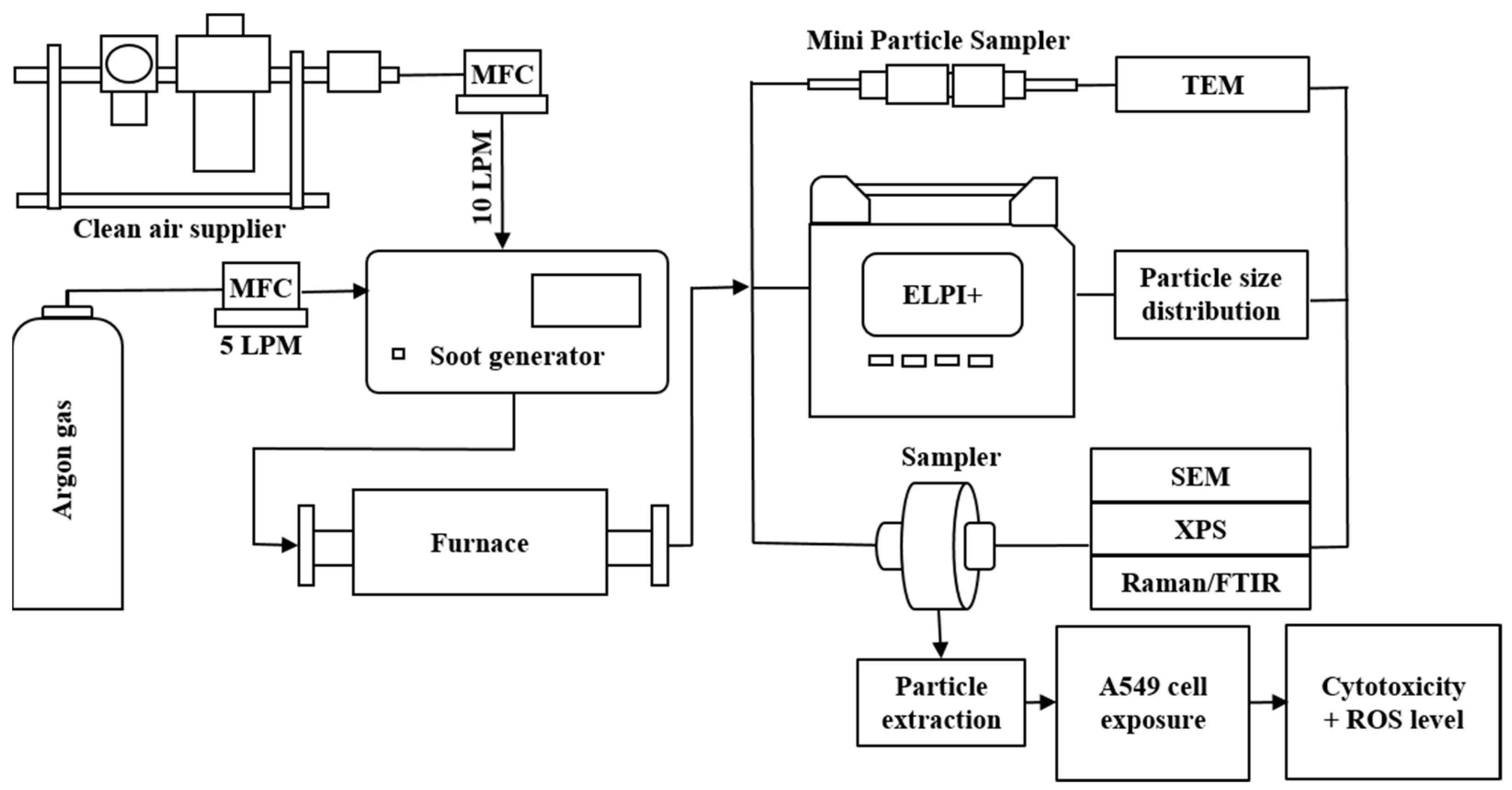
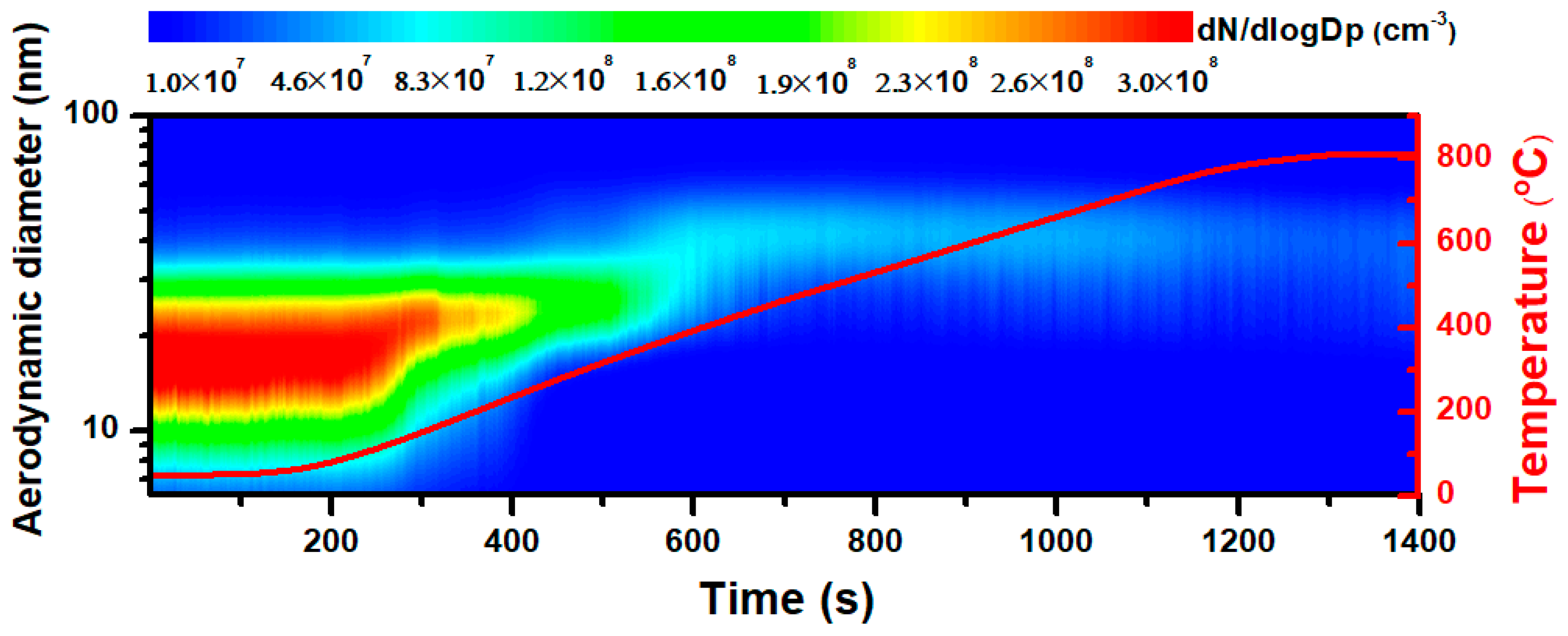
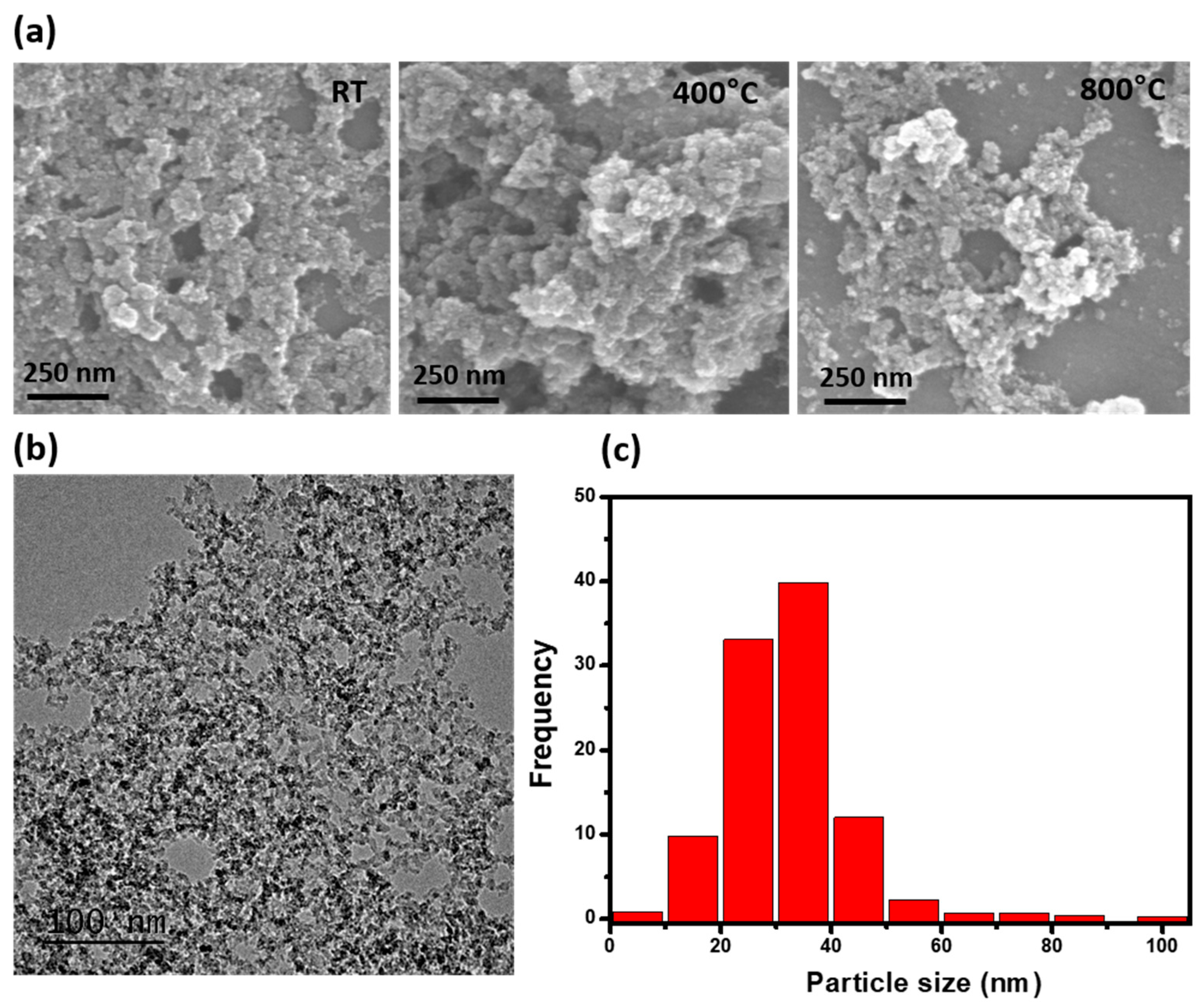
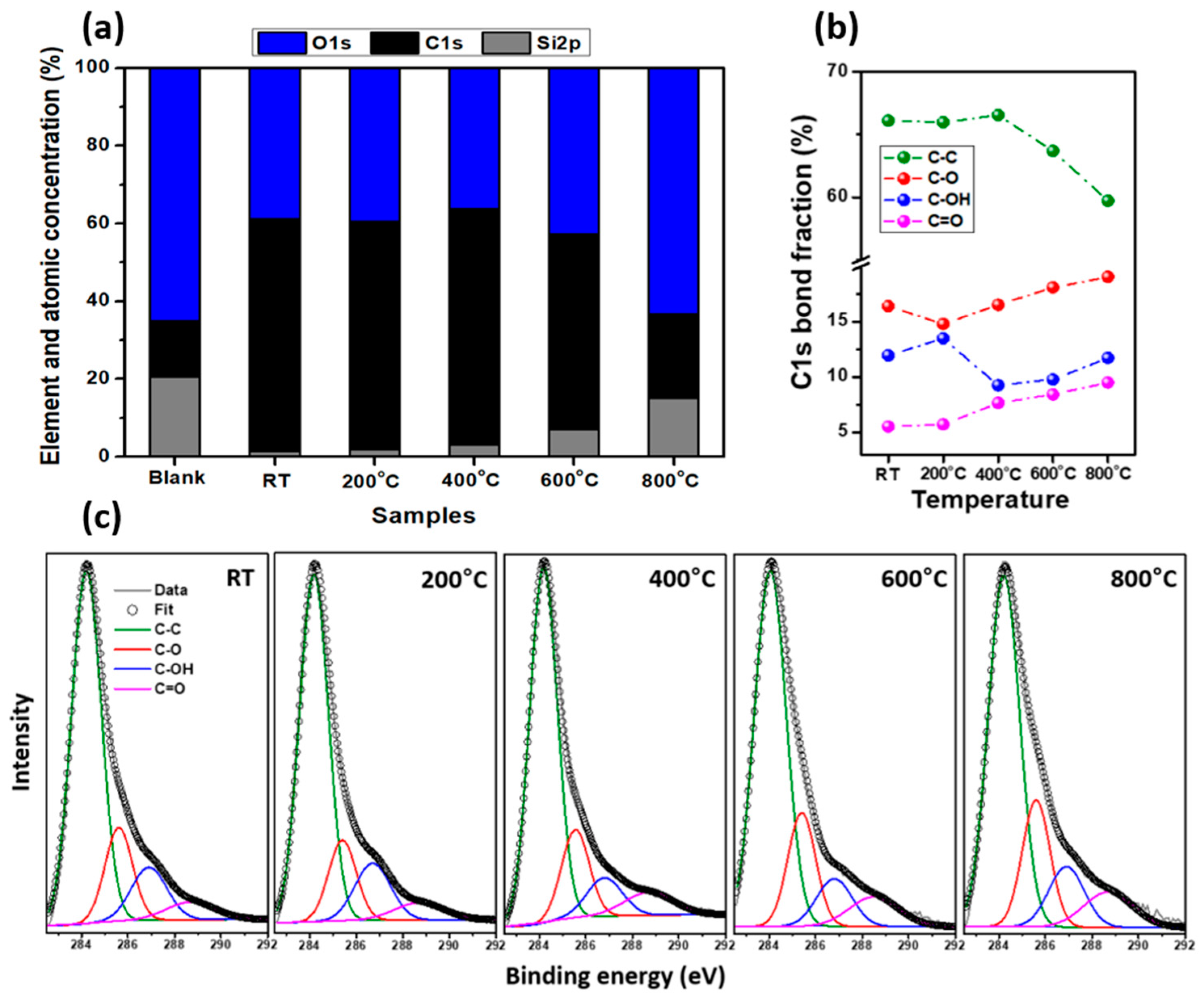
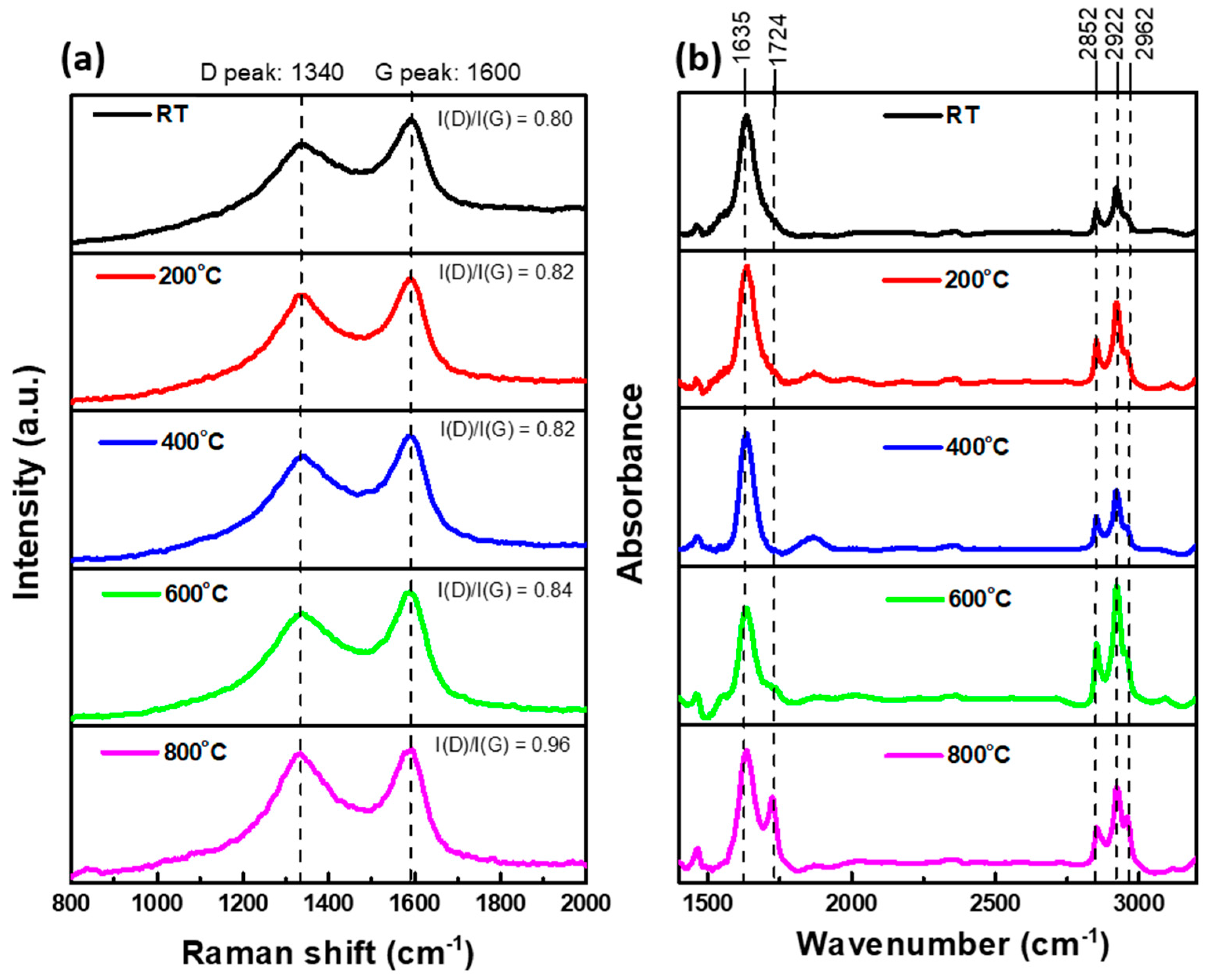

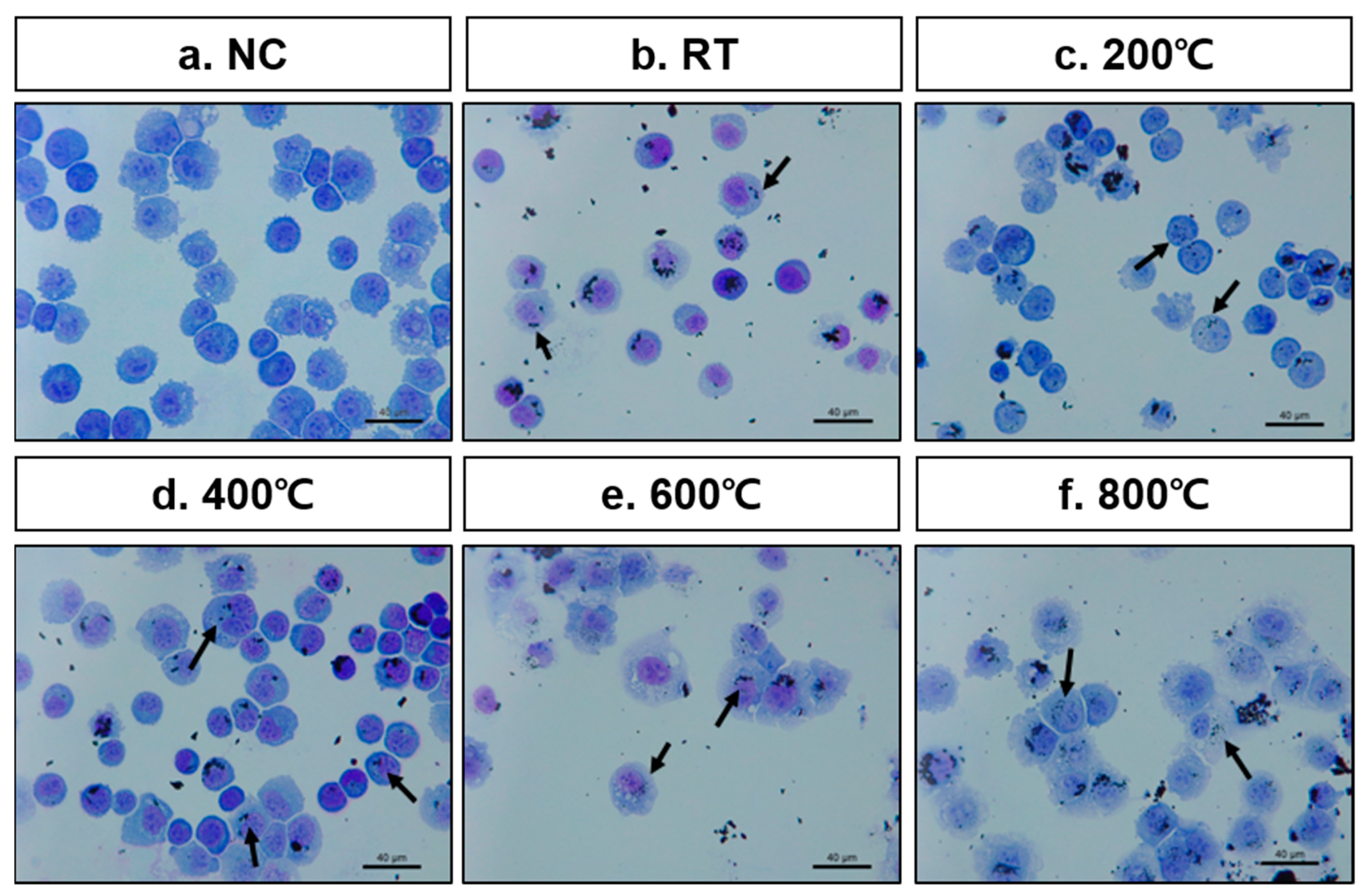
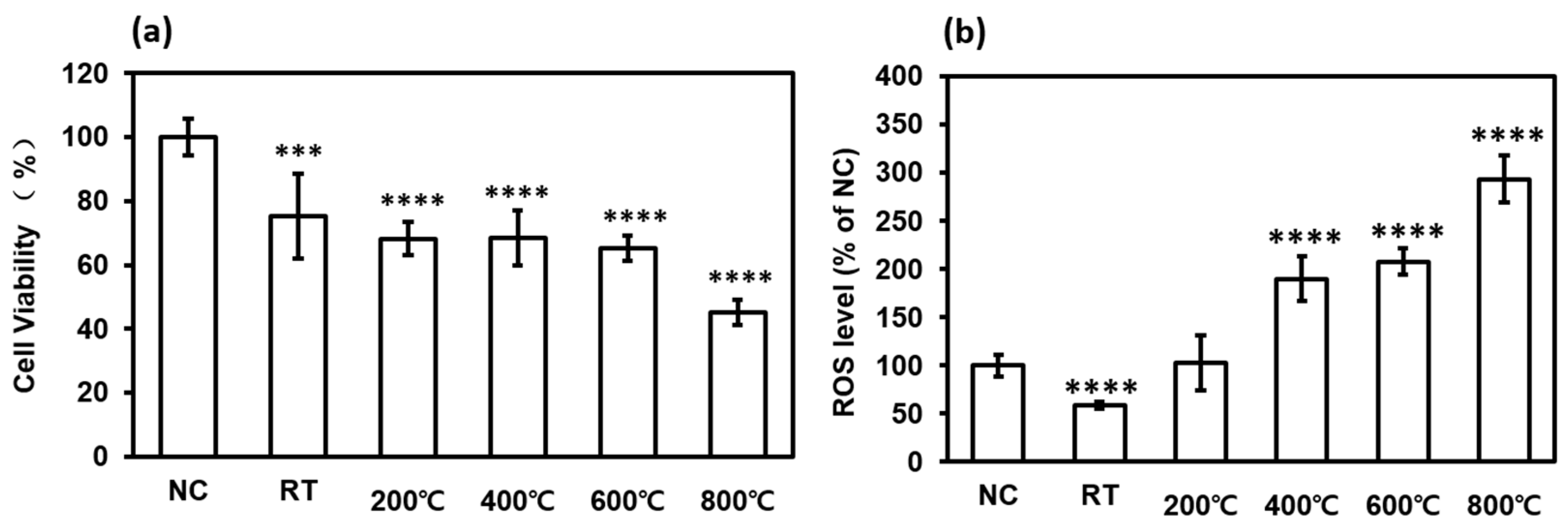
Publisher’s Note: MDPI stays neutral with regard to jurisdictional claims in published maps and institutional affiliations. |
© 2021 by the authors. Licensee MDPI, Basel, Switzerland. This article is an open access article distributed under the terms and conditions of the Creative Commons Attribution (CC BY) license (https://creativecommons.org/licenses/by/4.0/).
Share and Cite
Le, Y.T.-H.; Youn, J.-S.; Moon, H.-G.; Chen, X.-Y.; Kim, D.-I.; Cho, H.-W.; Lee, K.-H.; Jeon, K.-J. Relationship between Cytotoxicity and Surface Oxidation of Artificial Black Carbon. Nanomaterials 2021, 11, 1455. https://doi.org/10.3390/nano11061455
Le YT-H, Youn J-S, Moon H-G, Chen X-Y, Kim D-I, Cho H-W, Lee K-H, Jeon K-J. Relationship between Cytotoxicity and Surface Oxidation of Artificial Black Carbon. Nanomaterials. 2021; 11(6):1455. https://doi.org/10.3390/nano11061455
Chicago/Turabian StyleLe, Yen Thi-Hoang, Jong-Sang Youn, Hi-Gyu Moon, Xin-Yu Chen, Dong-Im Kim, Hyun-Wook Cho, Kyu-Hong Lee, and Ki-Joon Jeon. 2021. "Relationship between Cytotoxicity and Surface Oxidation of Artificial Black Carbon" Nanomaterials 11, no. 6: 1455. https://doi.org/10.3390/nano11061455
APA StyleLe, Y. T.-H., Youn, J.-S., Moon, H.-G., Chen, X.-Y., Kim, D.-I., Cho, H.-W., Lee, K.-H., & Jeon, K.-J. (2021). Relationship between Cytotoxicity and Surface Oxidation of Artificial Black Carbon. Nanomaterials, 11(6), 1455. https://doi.org/10.3390/nano11061455






